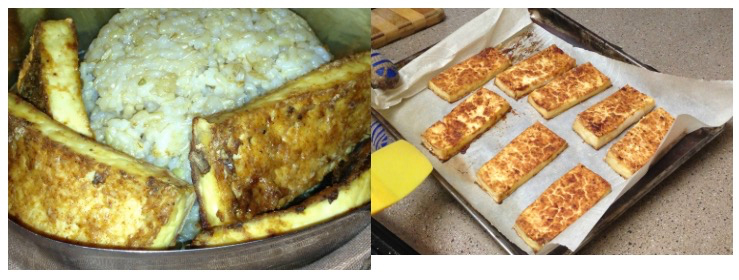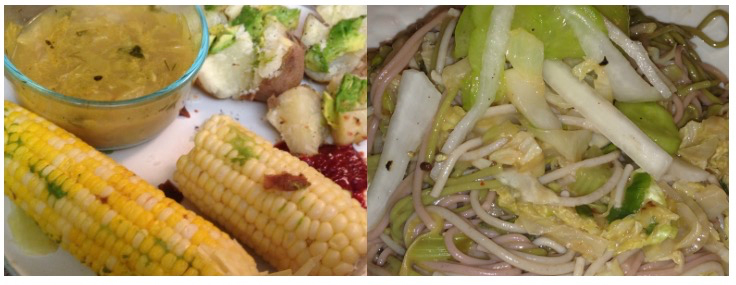The Shaolin Temple diet is a balanced way of eating that can help you live a long, active and healthy life. It provides a simple and streamlined formula for preparing vegan macrobiotic meals with relative ease. Learn how to eat like the Shaolin monks, some of the fittest and healthiest people on the planet.
So who are the Shaolin monks, and what is the traditional Shaolin Temple diet?
Anyone remember the 1970’s television series, ‘Kung Fu’ with David Carridine? Kwai Chang Caine, the patient and soft spoken yet formidable character portrayed by Carradine, was known for his impressive skills in the martial arts.
He was a Shaolin priest who grew up in the Shaolin Temple. His teachers imparted many great wisdoms taken from the Tao Te Ching, and Buddhist teachings, including vegetarianism.
The Shaolin monks are world renowned for their amazing athletic abilities. They practice Shaolin kung fu, which appears to synthesize every skill imaginable to thrive as a human~ mentally, spiritually, physically, and energetically.
They have learned to harness qi ~ called ‘heaven’s qi’ to perform seemingly impossible feats, and are unsurpassed in their integration of strength, flexibility, endurance, agility and coordination.
The Shaolin monks that live in the temple are Chinese Buddhists, but incorporate Taoist teachings in their form of Shaolin kung fu. Taoism teaches us to live in harmony with nature in order to be well and thrive.
They adhere to the Buddhist teachings of not killing, and therefore eat a vegetarian diet. The Shaolin Temple diet also excludes alcohol, and stimulating spices or odiferous foods, such as the onion family of vegetables, garlic, and ginger. These are thought to entice the emotions.
Considering how many of them live in close quarters, and how much they work out, it makes sense that they would avoid certain foods that could otherwise get in the way of their spiritual practices. Our version of the Shaolin Temple diet is a little more liberal with these spices.

The Shaolin Temple diet is strictly vegetarian among those who have taken the monks vows and live in the temples. Many people have a belief that one has to eat meat in order to have the energy, endurance, or muscular strength required of elite athletes such as the Shaolin monks, or other martial artists or body builders.
Here is how Sifu Wang Kiew Kit of the Shaolin Wahnam Institute responds to this question:
“It is a common misconception among many people that eating meat is necessary for providing the energy needed in vigorous kungfu. In fact the reverse is more probably true. Traditional Shaolin monks were strict vegetarians, and there was no doubt that they were tremendously powerful. Why? Where did they get their tremendous energy? About 80% was from heaven chi, i.e. from the cosmos, and 20% from grain chi, i.e. their vegetarian diet.
A meat eater might get more energy from his grain chi, but as toxic waste from meat is more than that from vegetables, and as toxic waste clogs meridians along which heaven chi flows, his net energy gain will be less than that of a vegetarian, if both practise genuine kungfu, which includes chi kung, i.e. the art of energy management.”

The Shaolin Temple diet consists of:
- Eight Treasures Congee for breakfast at 6 AM ~ recipe varies according to the season
- Lunch from 11:30-12:30 ~ Tofu, rice & 5-6 types of vegetables
- Dinner at 5:30 ~ Noodles and bread made from black or yellow wheat
The Shaolin Temple diet focuses on a bean and grain congee made with added nuts, seeds, and dried fruit such as goji berries or Chinese dates, a protein- and veggie-rich lunch, and a simple, carbohydrate-rich dinner.
The Eight Treasures Congee is perfect fuel prior to their intensive training. The protein at lunch helps them remain fueled and focused for more training in the afternoon. A lighter carbohydrate-rich dinner is perfect for their evening of winding down, chanting, meditation, and early bed.

Eight Treasures refers to the 8 different ingredients. Certain numbers are considered very auspicious in traditional Chinese belief systems.
The specific ingredients and food-based herbal products are chosen according to their properties to restore balance to someone’s health, and are adjusted according to the seasons.
It is believed that regular consumption of this Eight Treasures Congee (the name is the same despite many varied recipes) is key for longevity. In deed, in regions where this is a traditional part of the diet, such as among the Shaolin, they live long, healthy lives.

The Shaolin Temple diet includes a big plate of tofu, rice and 5-6 types of vegetables for lunch.

Lunch Time!
Eating the Shaolin Temple diet – Simple Seasoned Baked Tofu

Quick Boil (QB) Asian Vegetable Medley with
Lemon, Hemp & Tahini Dressing – Served with Tofu & Rice as part of the Shaolin Temple Diet lunch

5-6 Different veggies ~ Asian Vegetable Medley shown includes baby bok choy, Chinese broccoli, Taiwanese cabbage, scallions and carrots
For dressing:
Juice of half a lemon
1 Tbsp. hemp oil (or XV olive oil, cold pressed sesame oil, or flax oil)
1 Tbsp. tahini
1+ tsp. real maple syrup
~2 tsp. naturally fermented, low-sodium soy sauce
Cut veggies into even shapes, boiling the veggies in a pot with about 4 inches of water, and a pinch of salt brought to a boil. Bring back to a boil after immersing veggies, then scoop them out into a heat proof bowl. Continue until all the veggies are cooked. Some need only a quick dunking, some may take a moment longer.
Place ingredients for dressing in a jar. Shake.
Do a quick taste test and adjust with a dash of salt, more soy sauce, more lemon, or more syrup, as desired. Toss half with the veggies, save the rest for the next day.

Dinner as part of the Shaolin Temple diet is light, and carbohydrate-rich.
This can be something like a simple meal of steamed sweet corn on the cob (great with ume plum and/or avocado rubbed on) and steamed organic russet potatoes (also good with avocado, or dipped in ketchup – plain, or with dijon mustard or nutritional yeast flakes); a noodle dish; or bread –
Japanese Noodles with a Tangy Miso Sauce
- Your favorite Japanese or Asian noodles ~ pictured above was three different bundles: 1 Green Tea noodle, 1 buckwheat noodle, and 1 sorghum noodle. These noodles are made with the whole grain, and little else. Many noodles are very high in sodium, so read the labels!
- Lots of thin cut napa cabbage, bok choy, or green cabbage
- 2-3 Scallions, sliced (reserve a few for garnish)
- 1 celery stalk, thinly sliced ~ or use the small, young, inner celery stalk with the leaves
- 2 tsp. oil for stir fry
- 1 tbsp. barley, or younger red miso paste (if using a milder white/yellow miso, add a tiny bit of soy sauce, or use more miso paste)
- .5 tbsp. peanut butter
- 1/4 cup organic ketchup or tomato paste
- About .5 tsp. rice vinegar
- .5-1 tsp. chili garlic sauce, or less if using Sriracha
- 1 tsp. brown sugar (optional)

- Cook noodles according to package instructions. The Japanese noodles we use cook within 5 minutes. Drain, then rinse with cold water.
- Heat a wok, or large pan on medium-high. Add oil (canola, sesame, or your favorite for using with a higher heat.)
- Carefully add scallions and celery. Stir with a wood spatula, cooking until lightly browned. Add cabbage, and cook, stirring until translucent or soft. Add 1-2 tablespoons of water while cooking to ‘steam’ the veggies, and prevent sticking.
- Meanwhile, combine the rest of the ingredients in a small bowl. Add a couple tablespoons of water, and mash the miso and peanut butter up using the back of a spoon against the side of the bowl, or two spoons pressing together.
- Toss noodles, veggies and sauce all together ~ either in a big bowl, or in the pan, which ever is easier. Garnish is desired with remaining scallions, and a few chopped dry roasted peanuts.

The pasta is good topped with this refreshing Pickled Daikon Radish & Cucumber Salad ~
Thin slice peeled cucumber on the bias ~ smaller cucumbers are especially good
Cut daikon into matchsticks
Toss together with 1-2 tsp. ume plum vinegar ~ Good immediately, and lasts for a few days. Very refreshing!

Off-Grid Builders, Earthship Home Designs
Note: We design and build all over the USA and around the world.
What is a Biotecture Home?
A Biotecture building is a type of passive solar house that is made of both natural and upcycled materials (such as earth-packed tires). ‘Biotectures’ can be completely off-grid or partially off-grid.
Biotectures can be built in any part of the world, in any climate (with a permit) and still provide electricity, potable water, contained sewage treatment and sustainable food production.
Biotectures are thermal mass homes first, passive solar homes second.
Whatever temperature goes into a Biotecture building, it will hold… and since it is also a Passive Solar House, it is also very tight and interacts only with the sun and the earth for heating and cooling, providing stable comfort year round in any climate. This results in being able to provide a sustainable home on property that may not be situated to the ideal of 13.5 degrees east of south.





Many individuals today are adopting Shaolin diet principles to improve their health. For example, a recent study highlighted a group of athletes who switched to a plant-based diet inspired by the Shaolin monks. They reported increased energy levels and improved recovery times, demonstrating the diet’s effectiveness in supporting physical performance.